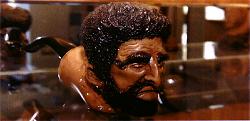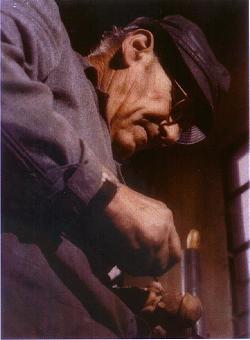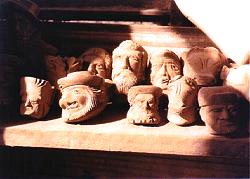Dorelio smiles at this. "The mistakes are important," he says. "More is learned from failure than from success. And many things can be learned only by making many, many pipes and many, many mistakes."
After years of working with his father, Damiano is reaching a point where his own pipes may soon be included in the Ardors coming to the United States. "I hope to be able to put my name on some pipes, maybe this year, maybe next year," he says. "I am not in a hurry. My father will tell me when the time is right." His pipes clearly differentiate his own artistic vision from that of his father's. They have the distinctive Ardor creativity, but also distinguish themselves in design. As these two craftsmen work together, exciting changes in Ardor design are a surety.
But many things will not change, such as the unwavering commitment to handcrafted excellence that has become standard to Ardor pipes. This excellence starts with the right materials. The briar used is Sardinian, Ligurian and Calabrian-the best that can be found. And this briar is bought at every opportunity, so that it can age properly. "We go directly to the different sources to analyze and choose the best briar," says Dorelio. "And the different growing areas require that we buy briar at different specific times of the year, to guarantee the best that can be had from that area. Our briar is our bank. We must always have enough aged briar on hand for any potential needs."
The workshop has been designed for the optimum drying and aging of the briar, with a large sliding
 door (very much like a garage door) in the
briar storage area, so that the right airflow may be maintained. Depending on the
temperature, humidity and amount of wind on any given day, it is opened appropriately.
"Briar must be properly dried," says Dorelio. "There can be no wind on the
briar for some years. Then it must be in a place with some light breeze through the
windows. It must not dry too quickly, or become too dry, because it will crack. Correct
air drying takes from 10 to 12 years."
door (very much like a garage door) in the
briar storage area, so that the right airflow may be maintained. Depending on the
temperature, humidity and amount of wind on any given day, it is opened appropriately.
"Briar must be properly dried," says Dorelio. "There can be no wind on the
briar for some years. Then it must be in a place with some light breeze through the
windows. It must not dry too quickly, or become too dry, because it will crack. Correct
air drying takes from 10 to 12 years."In another part of the large shop, exceptional, very old briar is stored for special edition pipes. "This is the best of the best," says Dorelio picking up a couple of the blocks of this special wood. "Listen." He claps two ebauchons together, and the clock sound they make pleases him.
The factory has up to five workers at any given time, but all the pipes are hand-finished by Dorelio himself. The other staff are part-time, and perform only the preliminary steps in the manufacturing, such as sorting the briar and drawing shapes on the blocks with templates of standard shapes. But the carving and finishing is all done by hand by Dorelio, and to some extent by Damiano. The "handmade" designation is taken very seriously here.
The stems are shaped from acrylic stock, in either black or brown. No production blanks are used-each Ardor stem is cut from rods, drilled, shaped and bent by hand. Many Ardor stems are cut in the signature Pennellessa shape. The word means "paintbrush," and designates the widening of the mouthpiece near the lip button, a design that guarantees comfort for the smoker.

There are no templates for the bend of the stems-each is heated and bent to fit the personality of the individual pipe. "Even with pipes in standard shapes," says Damiano, "each is different from all others. You can line up 10 pipes of the same shape, and see that they are truly handmade, because each is individual, each is subtly different in its own way."
This factory produces another line of pipes besides Ardor. It is the RoverArt line, which is marketed primarily in Europe, though a few have come to the United States. These pipes, named with musical themes (Melody, Armony, Sinfony etc.) differ from Ardor in stain colors and design, but are also handmade to the highest standards of the Ardor company.
Pride and passion may be the best emotions for defining Ardor pipes. Four generations of dedication cannot be lightly regarded, and pride in that heritage is well-deserved. This pipe company is based on family, and past generations are not forgotten, but revered. Angelo Rovera, who passed away last year, is still present, in a way. His workbench sits just as it did, with half-carved pipes on the shelf above it, exactly as he left them. He is missed, but not entirely gone, and his influence is still felt.
Second-generation carver Angelo Rovera, below, died last year. Well known for his detailed carvings, his workbench still stands in the Ardor workshop just as it was when he last worked at it, with several partially finished pipes lined along his shelf, never to be completed.

Angelo's Workbench (pictured below)

(Click Here to Return to the Previous Page)
Finishes
Venere Due Punti (Venus Two Points) Natural straight grain
Venere (Venus) Smooth honey or natural color
Mercurio (Mercury) Smooth light orange color
Giove (Jupiter) Smooth walnut color
Plutone (Pluto) Smooth Bordeaux lacquer
Nettuno (Neptune) Smooth black lacquer
Marte Sabbiata (Mars sandblast) Tan, brown, or red/brown sandblast
Meteora (Meteor) Carved rock with smooth chips
Urano Roccia (Uranus rusticate) Tan, black or red/brown rusticate
Moon carved with moon craters
Fantasy acrylic rings on shank and mouthpiece
Fresh Smoke screw-in bowls
Tulipano carved tulip leaves, and acrylic on shank
Pipa Sculpite carved animals and famous faces
Diva graceful small ladies' pipes
Sherlock Holmes special yearly series, calabash shape
Brissie limited series, calabash made with 35- year-old briar in three sandblast finishes
Modelli Originalli original shapes
Gurino curves with saddle mouthpiece
Detective famous detectives Holmes, Maigret, Marlowe
Damiano briar bulb on mouthpiece
Dimitri small pipes with silver rings
Bucaneve chubby pipes with silver rings
Ninfea slender silver spigot
Tabacco carved tobacco leaves
Bamboo bamboo shanks